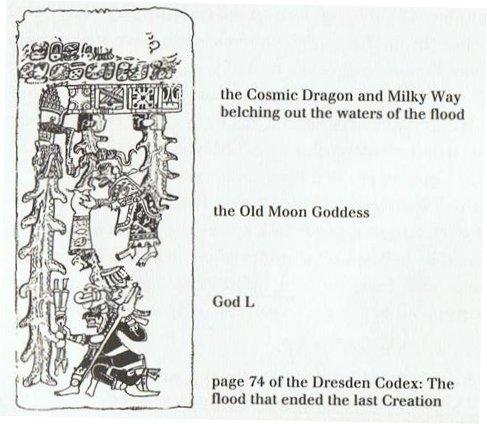2. The Mayan Dresden Codex describes how the Flood destroys the old world (cfr at Camp 8):
"... he [Karl Taube] showed me [Linda Schele] how the revised pagination of the Dresden Codex places the desctructive flood immediately before the New Year's pages. The Maya - then and now - understood the end of one year and the beginning of the other to be dangerous times when one world was destroyed and another created. It was a replay of the original creation." (David Freidel, Linda Schele, and Joy Parker, Maya Cosmos. Three Thousand Years on the Shaman's Path.) Could the Stream from the Urn be this Flood?
Somewhere beyond the Flood a new world will rise fresh again and we may have located this point in time both according to the manzil system and according to the G text:
In the manzil system Sheratan 1 - the day after the heliacal rising of the Pleiades - is the beginning, whereas it could be the heliacal rising of Algol which determines the beginning according to G. Algol is positioned at the day Alrescha 5 (at 3h), 11 days earlier than Sheratan 1. In the manzil system this is day 355 from the beginning of the calendar. Similarly, from winter solstice to January 1 in the Gregorian calendar there are 10 days. Counting 65 (= 355 - 290) steps backwards from 'May 6 and Gb4-17 we will arrive at Gb2-27 (where 22 / 7 = π). Should we not be able to do so also from Gb8-13?
No, evidence indicates there could be 472 - 365 = 107 glyphs which are outside the solar year (and 455 - 348 = 107). The cycle of the solar year could according to the G text be closed at 3h. From equinox to the heliacal rising of Algol there are 46 days. The solar year seems to begin neither at winter solstice nor at equinox but later:
If we count from 'January 1 in the preceding year Algol will be in day number 365 + 126 = 491 and 491 - 136 = 355 (the day of winter solstice according to the Gregorian calendar). Our list of stars parallel with glyphs has reached a full cycle with the Stream from the Urn. | |||||||||||||||||||||||||||||||||||||||||||||||||||||||||||||||||||||||||||||||||||||||||||||||||||||||||||||||||||||||||||||||||||||||||||||||||||||||||||||||||||||||||||||||||||||||||||||||










